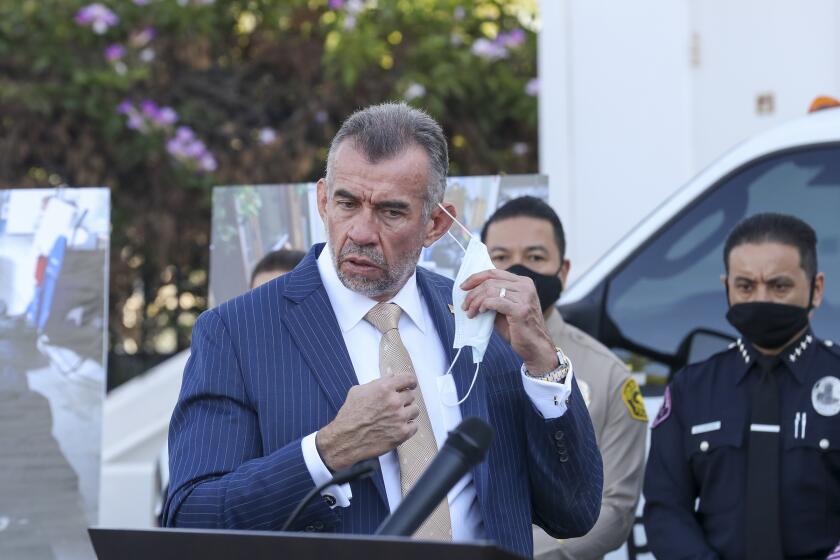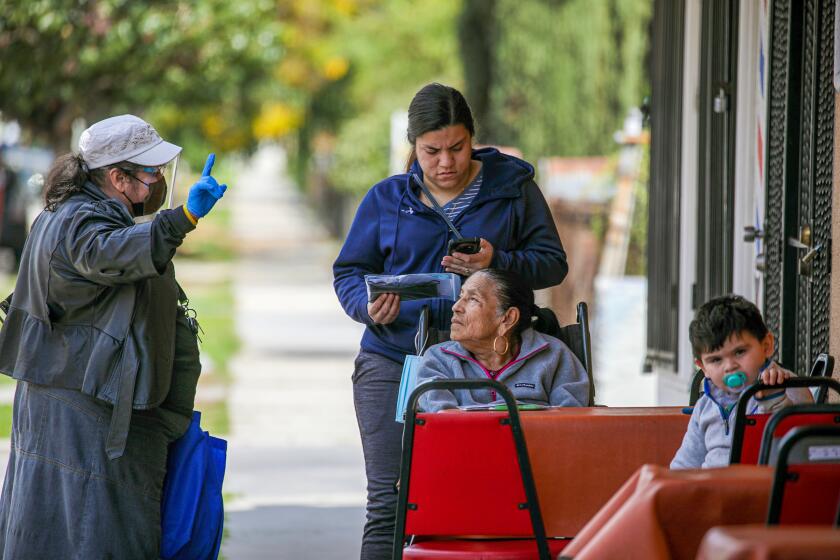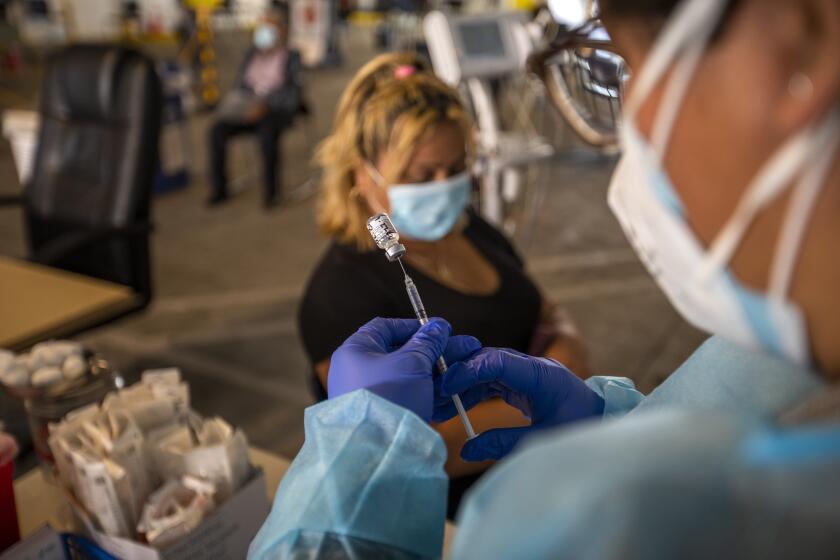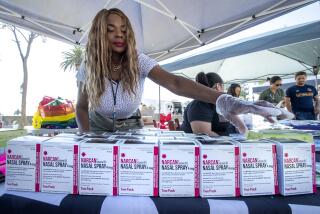L.A. County homeless deaths surged 56% in pandemic’s first year. Overdoses are largely to blame
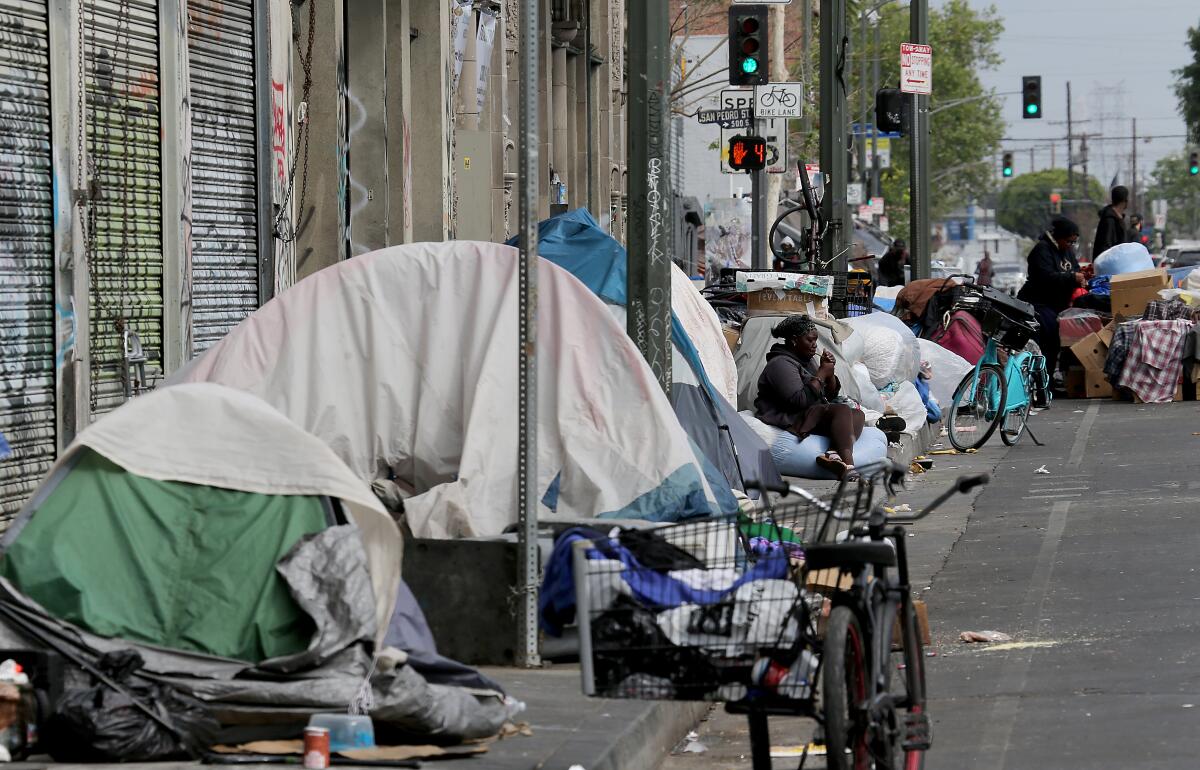
- Share via
Deaths of homeless people in Los Angeles County soared by 56% in the year after the start of the pandemic, driven primarily by an increase in overdoses, according to a study published this month.
Between April 1, 2020, and March 31, 2021, 1,988 deaths of people experiencing homelessness were reported, up from 1,271 in the 12 months prior, pre-pandemic, according to the Department of Public Health study.
The numbers in L.A. County mirror figures recorded in San Francisco over a similar time period; between March 2020 and March 2021, 331 homeless people died in the city, more than twice the number reported in any previous year, according to a study coauthored by scientists at UC San Francisco, the San Francisco Department of Public Health and New York University.
The L.A. County report, unlike past years, does not provide a homeless death rate due to restrictions put on the annual homeless count.
“The findings in this report reflect a true state of emergency on the streets across our County,” First District Supervisor Hilda L. Solis said in a release. “In a civil society, it is unacceptable for any of us to not be profoundly disturbed by the shocking needs documented in this year’s homeless mortality report.”
In the year surveyed, 179 homeless people died of COVID-19, accounting for about a quarter of the increase in overall deaths from the year prior.
Still, a surge in fatal overdoses was the primary driver of the increase. In the pre-pandemic year, the Department of Public Health reported just over 400 overdose deaths. In the year after the outbreak, that figure nearly doubled, to 715.
For some homeless advocates, the results are disturbing but not unexpected.
“Increases in overdoses are not surprising; we’ve seen it anecdotally,” said Homeless Healthcare Los Angeles medical director Dr. Susan Partovi. “We’re trying to give everyone Narcan [an overdose-reversing nasal spray] as much as possible.”
The cases underscore the degree to which the powerful synthetic opioid has pervaded the illegal drug market in Southern California. Most of the people who overdosed in the cases had used cocaine or counterfeit prescription pills that, unbeknown to them, were laced with fentanyl, according to prosecutors.
The pandemic likely exacerbated an already growing overdose issue, driven primarily by the prevalence of fentanyl, by making it more difficult for people experiencing homelessness to access care.
It’s harder to make an appointment for Suboxone, a medication used to treat opioid addiction, and to access any type of resources, Partovi said.
Partovi called for the implementation of safe injection sites, like those in New York City, to combat the opioid epidemic. Such sites allow the use of drugs while providing clean needles and other medical treatment as well as monitoring users for overdoses.
“We need to stop vilifying people who are addicted to drugs,” Partovi said.
Young, Latino and Black people experiencing homelessness bore the brunt of the increase in deaths, according to the report.
Overall deaths increased by more than 105% among those ages 18 to 29, by 69% among Latinos and by 58% among Black people.
Nearly 200 more Black homeless people died in the year after the start of the pandemic than in the year prior, while there were 334 more deaths among Latinos.
Wealth, poverty and race dramatically affect the toll of the coronavirus, with Latinos and Black communities in the county continuing to be hit hard.
Young, Latino and Black homeless people were also most affected by overdose deaths, with increases of more than 112% for both 18- to 29-year-olds and 30- to 49-year-olds, 84% for Latinos and 74% for Black people.
In addition, homicide deaths rose by nearly 50%, and deaths from traffic injuries rose by more than 30%.
The county has attempted to address barriers to care during the pandemic and worked to provide services and support to homeless people, including crisis response teams to connect unhoused people to coronavirus testing and vaccinations, said public health director Barbara Ferrer.
An estimated 65% of people experiencing homelessness in L.A. County have received at least one dose of vaccine, a decent but not ideal percentage, Ferrer said.
The county has made efforts to offer unhoused residents places where they can quarantine or be isolated, Ferrer said, and Project Roomkey hotel rooms can prevent medically vulnerable people from living in a situation that would create more danger for them because of COVID-19.
Over 10 months, COVID-19 vaccines prevented more than 1.5 million infections and about 20,000 deaths in California, a new study estimates.
“So I do want to give the county a lot of credit and all of the workers — and we’ve got a lot of private organizations as well helping — that have done everything we can,” she said. “But I still think the root of the problem of homelessness has, during the pandemic, led to an increase in mortality among people experiencing homelessness.”
The county plans to expand harm-reduction services with a focus on Latino and Black homeless people, increase the distribution of naloxone and expand investments in other areas of care.
But the report also notes that deaths of homeless people have been trending upward for years, without the aid of a pandemic.
“This recent increase, while notably large, is consistent with a longer-term trend … since 2014,” the report said.
More to Read
Sign up for Essential California
The most important California stories and recommendations in your inbox every morning.
You may occasionally receive promotional content from the Los Angeles Times.
